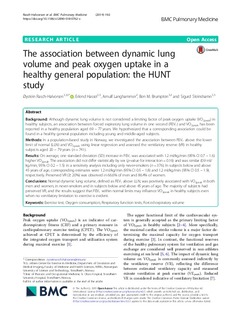| dc.contributor.author | Rasch-Halvorsen, Øystein | |
| dc.contributor.author | Steinshamn, Sigurd Loe | |
| dc.contributor.author | Hassel, Erlend | |
| dc.contributor.author | Brumpton, Ben Michael | |
| dc.contributor.author | Langhammer, Arnulf | |
| dc.date.accessioned | 2019-03-08T07:53:05Z | |
| dc.date.available | 2019-03-08T07:53:05Z | |
| dc.date.created | 2019-01-09T16:00:32Z | |
| dc.date.issued | 2019 | |
| dc.identifier.issn | 1471-2466 | |
| dc.identifier.uri | http://hdl.handle.net/11250/2589256 | |
| dc.description.abstract | Background
Although dynamic lung volume is not considered a limiting factor of peak oxygen uptake (VO2peak) in healthy subjects, an association between forced expiratory lung volume in one second (FEV1) and VO2peak has been reported in a healthy population aged 69 – 77 years. We hypothesized that a corresponding association could be found in a healthy general population including young and middle-aged subjects.
Methods
In a population-based study in Norway, we investigated the association between FEV1 above the lower limit of normal (LLN) and VO2peak using linear regression and assessed the ventilatory reserve (VR) in healthy subjects aged 20 – 79 years (n = 741).
Results
On average, one standard deviation (SD) increase in FEV1 was associated with 1.2 ml/kg/min (95% CI 0.7 – 1.6) higher VO2peak. The association did not differ statistically by sex (p-value for interaction = 0.16) and was similar (0.9 ml/kg/min, 95% CI 0.2 – 1.5) in a sensitivity analysis including only never-smokers (n = 376). In subjects below and above 45 years of age, corresponding estimates were 1.2 ml/kg/min (95% CI 0.5 – 1.8) and 1.2 ml/kg/min (95% CI 0.5 – 1.9), respectively. Preserved VR (≥ 20%) was observed in 66.6% of men and 86.4% of women.
Conclusions
Normal dynamic lung volume, defined as FEV1 above LLN, was positively associated with VO2peak in both men and women, in never-smokers and in subjects below and above 45 years of age. The majority of subjects had preserved VR, and the results suggest that FEV1 within normal limits may influence VO2peakin healthy subjects even when no ventilatory limitation to exercise is evident. | nb_NO |
| dc.language.iso | eng | nb_NO |
| dc.publisher | BMC (part of Springer Nature) | nb_NO |
| dc.rights | Navngivelse 4.0 Internasjonal | * |
| dc.rights.uri | http://creativecommons.org/licenses/by/4.0/deed.no | * |
| dc.title | The association between dynamic lung volume and peak oxygen uptake in a healthy general population: the HUNT study | nb_NO |
| dc.type | Journal article | nb_NO |
| dc.type | Peer reviewed | nb_NO |
| dc.description.version | publishedVersion | nb_NO |
| dc.source.volume | 19 | nb_NO |
| dc.source.journal | BMC Pulmonary Medicine | nb_NO |
| dc.source.issue | 2 | nb_NO |
| dc.identifier.doi | 10.1186/s12890-018-0762-x | |
| dc.identifier.cristin | 1653536 | |
| dc.description.localcode | © The Author(s). 2019 Open Access This article is distributed under the terms of the Creative Commons Attribution 4.0 International License (http://creativecommons.org/licenses/by/4.0/) | nb_NO |
| cristin.unitcode | 194,65,25,0 | |
| cristin.unitcode | 194,65,20,0 | |
| cristin.unitcode | 194,65,20,15 | |
| cristin.unitname | Institutt for sirkulasjon og bildediagnostikk | |
| cristin.unitname | Institutt for samfunnsmedisin og sykepleie | |
| cristin.unitname | Helseundersøkelsen i Nord-Trøndelag | |
| cristin.ispublished | true | |
| cristin.fulltext | postprint | |
| cristin.qualitycode | 1 | |

